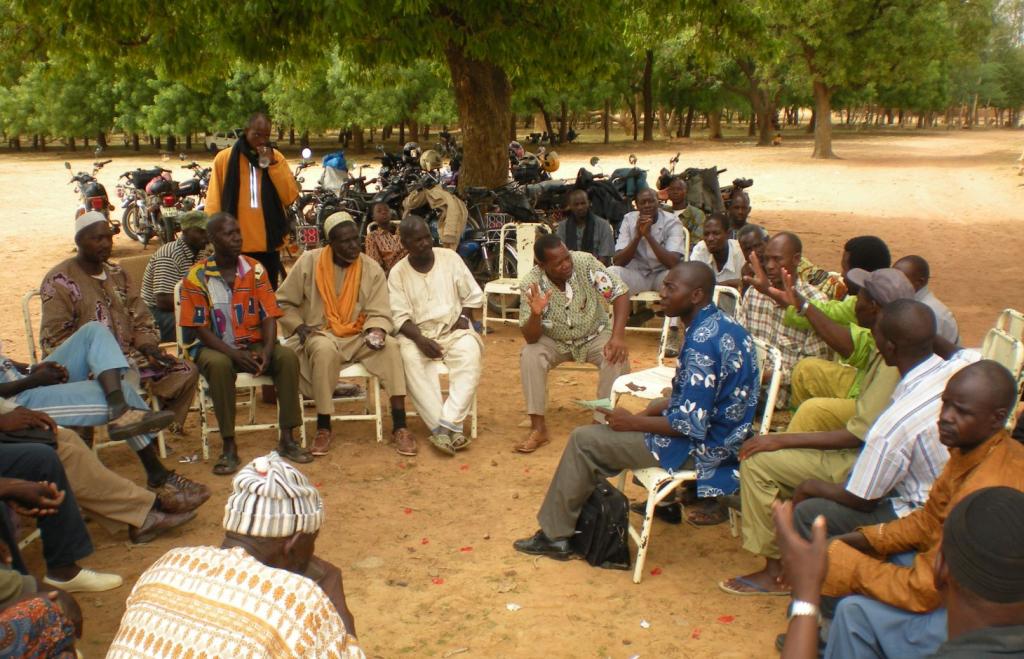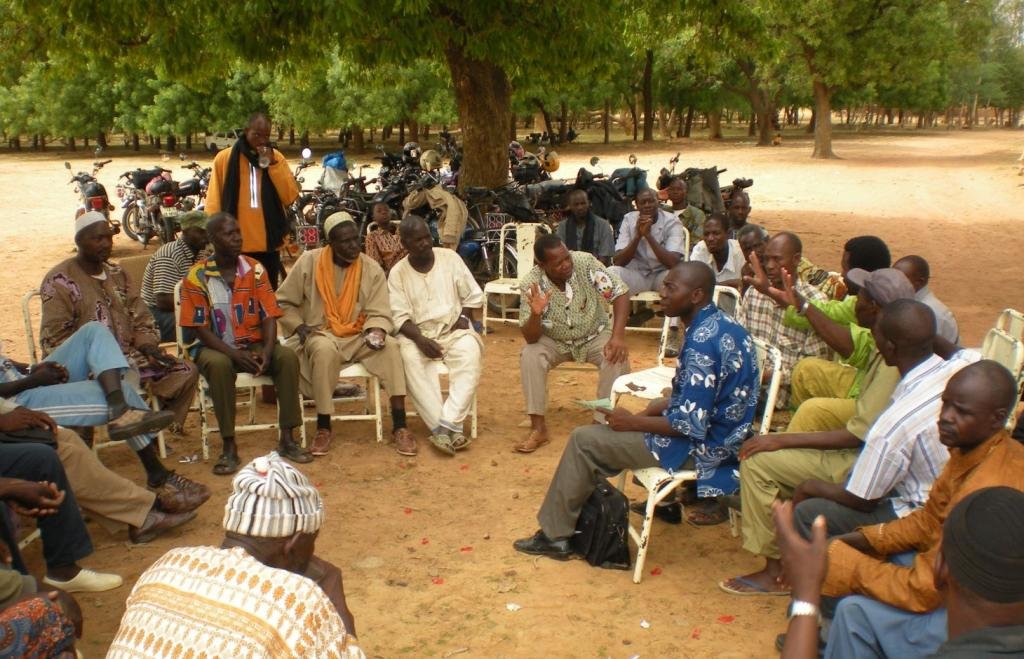Local agreements on the management of small-scale irrigation facilities [ប្រទេសម៉ាលី]
- ការបង្កើត៖
- បច្ចុប្បន្នភាព
- អ្នកចងក្រង៖ Dieter Nill
- អ្នកកែសម្រួល៖ –
- អ្នកត្រួតពិនិត្យ Laura Ebneter
Convention locale pour la gestion des aménagements hydro-agricoles
approaches_2504 - ប្រទេសម៉ាលី
ពិនិត្យមើលគ្រប់ផ្នែក
ពង្រីកមើលទាំងអស់ បង្រួមទាំងអស់1. ព័ត៌មានទូទៅ
1.2 ព័ត៌មានលម្អិតពីបុគ្គលសំខាន់ៗ និងស្ថាប័នដែលចូលរួមក្នុងការវាយតម្លៃ និងចងក្រងឯកសារនៃវិធីសាស្ត្រផ្សព្វផ្សាយ
អ្នកជំនាញឯកទេស SLM:
Mushinzimana Godihald
godihald.mushinzimana@giz.de
Deutsche Gesellschaft für Internationale Zusammenarbeit (GIZ)
ប្រទេសម៉ាលី
ឈ្មោះគម្រោងដែលបានចងក្រងឯកសារ/ វាយតម្លៃលើវិធីសាស្ត្រផ្សព្វផ្សាយ (បើទាក់ទង)
Programme for Territorial Communities, Mali (PACT)ឈ្មោះអង្គភាពមួយ (ច្រើន) ដែលបានចងក្រងឯកសារ/ វាយតម្លៃលើវិធីសាស្ត្រផ្សព្វផ្សាយ (បើទាក់ទង)
Deutsche Gesellschaft für Internationale Zusammenarbeit (GIZ) - ប្រទេសអាល្លឺម៉ង់1.3 លក្ខខណ្ឌទាក់ទងទៅនឹងការប្រើប្រាស់ទិន្នន័យដែលបានចងក្រងតាមរយៈវ៉ូខេត
តើពេលណាដែលទិន្នន័យបានចងក្រង (នៅទីវាល)?
01/07/2012
អ្នកចងក្រង និង(បុគ្គលសំខាន់ៗ)យល់ព្រមទទួលយកនូវលក្ខខណ្ឌនានាទាក់ទងទៅនឹងការប្រើប្រាស់ទិន្នន័យដែលបានចងក្រងតាមរយៈ វ៉ូខេត:
បាទ/ចា៎
2. ការពណ៌នាអំពីវិធីសាស្ត្រផ្សព្វផ្សាយ SLM
2.1 ពណ៌នាសង្ខេបខ្លីពីវិធីសាស្ត្រផ្សព្វផ្សាយ
Local agreements aim to prevent and consensually manage conflicts on a site and to manage natural resources to ensure they are used rationally and sustainably.
2.2 ពណ៌នាលម្អិតពិវិធីសាស្ត្រផ្សព្វផ្សាយ
ពណ៌នាលម្អិតពិវិធីសាស្ត្រផ្សព្វផ្សាយ:
A local agreement is a mutual agreement covering the ways in which shared natural resources are exploited in order to ensure their fair and sustainable use. As the national methodological guide puts it: ‘All agreements, written or otherwise, between two or more local actors and particularly social groups (socio-professional groups, village associations or communities, or factions), technical services and NGOs set the rules for accessing and using the resources in a way which ensures their conservation and their responsible and sustainable exploitation’.
The local agreement is the fruit of a series of consultation and negotiation forums involving local farmers and managers of a shared natural resource and is delivered with the support of local authorities and their technical services. These consultation and negotiation forums make it possible for all the actors involved to evaluate the status of the resource, identify problems and put forward possible solutions. The forums create a climate of trust among user groups who, despite the difficulties of living side-by-side, remain willing to come together around the same table. The management ideas resulting from the discussions and negotiations are laid down in the form of consensual management rules, collectively called the ‘local agreement’.
Stages of implementation: 1)Information and identification of key actors in the process of drawing up a local agreement. As it is not possible for everyone to participate in the consultation exercise, the process is based on delegation. 2)Natural resource diagnostic exercise: first taking a snapshot of the current state of the resource using tools like resource maps, Venn diagrams and matrices categorizing producers by product. Next, problems arising from resource exploitation and management, and possible solutions to these problems, are identified. 3)The results are fed back to actors who have not been involved in the diagnostic process in order to gather their inputs. 4)Drawing up the draft local agreement: analysing reaction to the diagnostic feedback in order to (i) take on board the most relevant inputs and (ii) flesh out and refine the ideas for regulatory solutions (concrete management rules and their associated sanctions – this constitutes the ‘draft local agreement’) without losing sight of the national legislation relating to the resource. It is during this stage that the mechanism for monitoring the implementation of the agreement is developed. 5)Feedback and validation of the draft: in order to refine the terms of the draft local agreement, the select committee instituted by all those participating in the process feeds back the results of its work and then debates them. Once the terms are agreed by all parties, it is considered validated. 6)The draft local agreement is signed by the local managers of the resource and is then considered by the territorial community and approved by the supervisory authority, where required. Hardcopies of the signed agreement are subsequently given out to key actors and it is disseminated through discussions in general meetings and on local radio. 7)Monitoring bodies are set up to monitor local agreement implementation at the village and commune levels and to deliver training on the roles and responsibilities required at these levels. 8)Monitoring and evaluation is carried out with regard to the implementation of the local agreement and the functioning of bodies tasked with monitoring the implementation.
Involved actors: Territorial communities, farmers and managers of natural resources, technical services, financial support structure.
2.3 រូបភាពនៃវិធីសាស្ត្រផ្សព្វផ្សាយ
2.5 ប្រទេស/តំបន់/ទីតាំងកន្លែង ដែលវិធីសាស្ត្រផ្សព្វផ្សាយត្រូវបានអនុវត្តន៍
ប្រទេស:
ប្រទេសម៉ាលី
តំបន់/រដ្ឋ/ខេត្ត:
Mali
បញ្ជាក់បន្ថែមពីលក្ខណៈនៃទីតាំង:
Sikasso, Mopti, Koulikoro, Timbuktu
2.6 កាលបរិច្ឆេទនៃការចាប់ផ្តើម និងបញ្ចប់នៃវិធីសាស្រ្តផ្សព្វផ្សាយនេះ
សូមបញ្ជាក់ឆ្នាំដែលបានបង្កើតឡើង:
2004
2.7 ប្រភេទនៃវិធីសាស្ត្រផ្សព្វផ្សាយ
- ផ្អែកលើគម្រោង/កម្មវិធី
2.8 គោលបំណង/ទិសដៅសំខាន់នៃវិធីសាស្ត្រផ្សព្វផ្សាយ
The Approach focused mainly on SLM with other activities
Agreements between different actors on the sustainable and fair use of shared natural resources, reduction of conflicts
The SLM Approach addressed the following problems: conflicts on and unsustainable use of natural resources
2.9 លក្ខខណ្ឌអនុញ្ញាត ឬរារាំងការអនុវត្តន៍បច្ចេកទេសដែលស្ថិតនៅក្រោមវិធីសាស្រ្តផ្សព្វផ្សាយ
បរិបទនៃស្ថាប័ន
- រារាំង
conflicts and missing agreement on sustainable use of natural resources
Treatment through the SLM Approach: A local agreement is a mutual agreement covering the ways in which shared natural resources are exploited in order to ensure their fair and sustainable use. All agreements between two or more local actors and particularly social groups (socio-professional groups, village associations or communities, or factions), technical services and NGOs set the rules for accessing and using the resources in a way which ensures their conservation and their responsible and sustainable exploitation’.
3. ការចូលរួម និងតួនាទីរបស់ភាគីពាក់ព័ន្ធ
3.1 អ្នកពាក់ព័ន្ធដែលបានចូលរួមក្នុងវិធីសាស្ត្រផ្សព្វផ្សាយ និងតួនាទីរបស់ពួកគេ
- អ្នកប្រើប្រាស់ដីក្នុងតំបន់/សហគមន៍
- អ្នកឯកទេសគ្រប់គ្រងដីប្រកបដោយចីរភាព/ទីប្រឹក្សាបច្ចេកទេសកសិកម្ម
- រដ្ឋាភិបាលថ្នាក់ជាតិ (អ្នករៀបចំផែនការ អ្នកសម្រេចចិត្ត)
- អង្គការអន្តរជាតិ
3.2 ការចូលរួមរបស់អ្នកប្រើប្រាស់ដីក្នុងតំបន់/ សហគមន៍ក្នុងតំបន់ក្នុងដំណាក់កាលផ្សេងគ្នានៃវិធីសាស្រ្តផ្សព្វផ្សាយ
| ការចូលរួមរបស់អ្នកប្រើប្រាស់ដីក្នុងតំបន់/សហគមន៍ក្នុងតំបន់ | សូមបញ្ជាក់នរណាត្រូវបានចូលរួម ព្រមទាំងពណ៌នាសកម្មភាពទាំងនោះ | |
|---|---|---|
| ការចាប់ផ្តើម/ការលើកទឹកចិត្ត | អន្តរកម្ម | |
| ការរៀបចំផែនការ | អន្តរកម្ម | |
| ការអនុវត្តន៍ | អន្តរកម្ម | |
| ការត្រួតពិនិត្យ និងវាយតម្លៃ | អន្តរកម្ម | |
| Research | អសកម្ម |
3.4 ការសម្រេចចិត្តលើការជ្រើសរើសបច្ចេកទេស SLM
សូមបញ្ជាក់តើអ្នកណាជាអ្នកបានសម្រេចចិត្តក្នុងការជ្រើសរើសបច្ចេកទេសដើម្បីយកមកអនុវត្តន៍:
- អ្នកប្រើប្រាស់ដី ដោយមានការគាំទ្រពីអ្នកជំនាញឯកទេស SLM
4. ជំនួយបច្ចេកទេស ការកសាងសមត្ថភាព និងការគ្រប់គ្រងចំណេះដឹង
4.1 ការកសាងសមត្ថភាព/ បណ្តុះបណ្តាល
តើវគ្គបណ្តុះបណ្តាលបានផ្តល់ឱ្យអ្នកប្រើប្រាស់ដី/អ្នកពាក់ព័ន្ធផ្សេងៗទៀតដែរឬទេ?
បាទ/ចា៎
សូមបញ្ជាក់តើអ្នកណាត្រូវបានបណ្តុះបណ្តាល:
- អ្នកប្រើប្រាស់ដី
ទម្រង់នៃការបណ្តុះបណ្តាល:
- ការប្រជុំជាសាធារណៈ
4.2 សេវាផ្តល់ប្រឹក្សាយោបល់
តើអ្នកប្រើប្រាស់ដីបានទទួលនូវសេវាផ្តល់ប្រឹក្សាដែរ ឬទេ?
បាទ/ចា៎
ពណ៌នា/ពន្យល់:
Advisory service is quite adequate to ensure the continuation of land conservation activities
4.3 ការពង្រឹងសមត្ថភាពស្ថាប័ន (ការអភិរឌ្ឍន៍អង្គភាព)
តើស្ថាប័នទាំងអស់ត្រូវបានបង្កើតឡើង ឬពង្រឹងសមត្ថភាពតាមរយៈវិធីសាស្ត្រផ្សព្វផ្សាយដែរ ឬទេ?
- បាទ/ច៎ា ជាមធ្យម
សូមបញ្ជាក់ថាតើស្ថាប័នត្រូវបានពង្រឹង ឬបង្កើតឡើងនៅត្រឹមកម្រិតណា(ច្រើន)?
- ថ្នាក់មូលដ្ឋាន
សូមបញ្ជាក់ប្រភេទនៃការគាំទ្រ:
- ហិរញ្ញវត្ថុ
- ការកសាងសមត្ថភាព/ បណ្តុះបណ្តាល
4.4 ការត្រួតពិនិត្យ និងវាយតម្លៃ
តើការត្រួតពិនិត្យ និងវាយតម្លៃគឺជាផ្នែកមួយនៃវិធីសាស្ត្រដែរឬទេ?
បាទ/ចា៎
មតិយោបល់:
technical aspects were ad hoc monitored by project staff, land users through observations;
socio-cultural aspects were ad hoc monitored by project staff, land users through observations;
management of Approach aspects were ad hoc monitored by project staff, land users through observations;
bio-physical aspects were ad hoc monitored by None through observations;
There were no changes in the Approach as a result of monitoring and evaluation;
There were no changes in the Technology as a result of monitoring and evaluation;
4.5 ការស្រាវជ្រាវ
តើការស្រាវជ្រាវ គឺជាផ្នែកមួយនៃវិធីសាស្រ្តដែរឬទេ?
បាទ/ចា៎
បញ្ជាក់ប្រធានបទ:
- សង្គមវិទ្យា
- សេដ្ឋកិច្ច/ទីផ្សារ
- បរិស្ថានវិទ្យា
- បច្ចេកវិទ្យា
5. ថវិកា និងសម្ភារៈឧបត្ថម្ភពីខាងក្រៅ
5.1 ថវិកាប្រចាំឆ្នាំសម្រាប់ផ្សព្វផ្សាយ SLM
ប្រសិនបើចំនួនពិតប្រាកដនៃថវិកាប្រចាំឆ្នាំមិនត្រូវបានដឹងច្បាស់ សូមប្រាប់ពីចន្លោះនៃថវិកានោះ:
- 2,000-10,000
មតិយោបល់ (ឧ. ប្រភពសំខាន់នៃមូលនិធិ/ម្ចាស់ជំនួយចំបង):
Approach costs were met by the following donors: international: 100.0%
5.2 ការគាំទ្រផ្នែកហិរញ្ញវត្ថុ / សម្ភារៈដែលបានផ្តល់ទៅឱ្យអ្នកប្រើប្រាស់ដី
តើអ្នកប្រើប្រាស់ដីបានទទួលការគាំទ្រផ្នែកហិរញ្ញវត្ថ/សម្ភារៈសម្រាប់ការអនុវត្តន៍បច្ចេកទេសដែរឬទេ:
បាទ/ចា៎
5.3 សូមបញ្ជាក់ពីធាតុចូលត្រូវបានផ្តល់បដិភាគ (រួមទាំងកម្លាំងពលកម្ម)
ប្រសិនបើកម្លាំងពលកម្មធ្វើដោយអ្នកប្រើប្រាស់ដី តើវាជាធាតុចូលដ៏សំខាន់មួយដែរ ឬទេ:
- ដោយស្ម័គ្រចិត្ត
6. ការវិភាគរកផលប៉ះពាល់ និងសេចក្តីសន្និដ្ឋាន
6.1 ផលប៉ះពាល់នៃវិធីសាស្ត្រផ្សព្វផ្សាយ
តើវិធីសាស្ត្រផ្សព្វផ្សាយជួយអ្នកប្រើប្រាស់ដីដើម្បីអនុវត្តន៍ និងថែទាំបច្ចេកទេស SLM?
- ទេ
- បាទ/ច៎ា បន្តិចបន្តួច
- បាទ/ច៎ា ជាមធ្យម
- បាទ/ច៎ា បានខ្លាំង
All agreements, written or otherwise, between two or more local actors and particularly social groups (socio-professional groups, village associations or communities, or factions), technical services and NGOs set the rules for accessing and using the resources in a way which ensures their conservation and their responsible and sustainable exploitation.
តើវិធីសាស្ត្រផ្សព្វផ្សាយនេះផ្តល់សិទ្ធិអំណាចដល់សង្គមនិងសេដ្ឋកិច្ចដែលក្រុមមិនទទួលបានផលប្រយោជន៍?
- ទេ
- បាទ/ច៎ា បន្តិចបន្តួច
- បាទ/ច៎ា ជាមធ្យម
- បាទ/ច៎ា បានខ្លាំង
The consultation and negotiation forums make it possible for all the actors involved to evaluate the status of the resource, identify problems and put forward possible solutions.
Did other land users / projects adopt the Approach?
- ទេ
- បាទ/ច៎ា បន្តិចបន្តួច
- បាទ/ច៎ា ជាមធ្យម
- បាទ/ច៎ា បានខ្លាំង
Implementation locations: Sikasso, Mopti, Koulikoro, Timbuktu and others. A local agreement for managing natural resources usually applies for between three to five years. At the end of this period, the agreement must be evaluated in order to take account of new developments. PACT has been using these local agreements since 2004.
Did the Approach lead to improved livelihoods / human well-being?
- ទេ
- បាទ/ច៎ា បន្តិចបន្តួច
- បាទ/ច៎ា ជាមធ្យម
- បាទ/ច៎ា បានខ្លាំង
The forums create a climate of trust among user groups who, despite the difficulties of living side-by-side, remain willing to come together around the same table.
Did the Approach help to alleviate poverty?
- ទេ
- បាទ/ច៎ា បន្តិចបន្តួច
- បាទ/ច៎ា ជាមធ្យម
- បាទ/ច៎ា បានខ្លាំង
6.2 ការលើកទឹកចិត្តចម្បងៗរបស់អ្នកប្រើប្រាស់ដីសម្រាប់ការអនុវត្តបច្ចេកទេស SLM
- បង្កើនផលិតកម្ម
- បង្កើនប្រាក់ចំណេញ (សមត្ថភាព) បង្កើនអត្រាចំណេញ
6.3 សកម្មភាពផ្សព្វផ្សាយដែលប្រកបដោយចីរភាព
តើអ្នកប្រើប្រាស់ដីអាចធ្វើឱ្យមានចីរភាពនូវអ្វីដែលត្រូវបានអនុវត្តន៍តាមរយៈវិធីសាស្ត្រផ្សព្វផ្សាយដែរឬទេ(ដោយពុំមានការគាំទ្រពីអ្នកខាងក្រៅ)?
- បាទ/ចា៎
ប្រសិនបាទ/ច៎ា សូមរៀបរាប់ថាធ្វើយ៉ាងម៉េច:
A local agreement for managing natural resources usually applies for between three to five years. At the end of this period, the agreement must be evaluated in order to take account of new developments. PACT has been using these local agreements since 2004.
The sustainability of the local agreement depends on the level to which its terms are taken up by those who developed it and who are responsible for implementing it. It also depends on the relevance of the regulatory and technical solutions taken forward for resolving the major issues identified in the diagnostic process.
6.4 ភាពខ្លាំង/ គុណសម្បត្តិនៃវិធីសាស្ត្រផ្សព្វផ្សាយ
| ភាពខ្លាំង/ គុណសម្បត្តិ/ ឱកាស ទស្សនៈរបស់បុគ្គលសំខាន់ៗ |
|---|
| More rational and sustainable exploitation of resources |
| Fairer access to developed lands |
| Consultative management of the shared resource |
| Reduction and prevention of conflicts (How to sustain/ enhance this strength: The diagnostic process must reflect reality, as expressed by the beneficiaries themselves. During the diagnostic process, beneficiaries must be given guidance but must not be directly influenced. The solutions put forward must come from the beneficiaries. There must be continuity in terms of key actor representation. The results from consultation exercises must be fed back into the process. Local authorities, supervisory bodies and technical services must be involved. A set of technical measures must be implemented based on the results of the diagnostic process. These measures must reinforce the management rules.) |
| Local agreements on managing developed lands and facilities are drawn up for the majority of hydro-agricultural schemes (How to sustain/ enhance this strength: There must be a system in place to take action against those breaking the terms of the convention (committees and technical services)) |
6.5 ភាពខ្សោយ/ គុណវិបត្តិនៃវិធីសាស្ត្រ និងរកដំណោះស្រាយ
| ភាពខ្សោយ/ គុណវិបត្តិ/ ហានិភ័យក្នុងទស្សនៈរបស់បុគ្គលសំខាន់ៗ | តើបច្ចេកទេសទាំងនោះបានដោះស្រាយបញ្ហាដូចម្តេច? |
|---|---|
|
Getting remote farmers – such as those in localities outside the scope of the local agreement – to respect the rules laid down in the local agreement can be problematic. |
|
| Once the scheme starts developing lands (increasing yields), new conflicts can arise (jealousy) |
7. ឯកសារយោង និងវេបសាយ
7.1 វិធីសាស្ត្រ/ ប្រភពនៃព័ត៌មាន
- តាមការចុះទីវាល ការស្រាវជ្រាវនៅទីវាល
- ការសម្ភាសន៍ជាមួយអ្នកប្រើប្រាស់ដី
7.2 ឯកសារយោងដែលបានចេញផ្សាយ
ចំណងជើង អ្នកនិពន្ធ ឆ្នាំ ISBN:
Manual of Good Practices in Small Scale Irrigation in the Sahel. Experiences from Mali. Published by GIZ in 2014.
មានប្រភពមកពីណា? ថ្លៃដើមប៉ុន្មាន?
http://star-www.giz.de/starweb/giz/pub/servlet.starweb
ចំណងជើង អ្នកនិពន្ធ ឆ្នាំ ISBN:
Guide méthodologique national, élaboration d’une convention locale de gestion des ressources naturelles [National methodological guide – Drawing up a local agreement to manage natural resources], MEA (Ministry of Environment and Sanitation), June 2011
ចំណងជើង អ្នកនិពន្ធ ឆ្នាំ ISBN:
Full-cost accounting of local agreements, PACT, October 2006
ចំណងជើង អ្នកនិពន្ធ ឆ្នាំ ISBN:
www.pact-mali.org
ការតភ្ជាប់ និងម៉ូឌុល
ពង្រីកមើលទាំងអស់ បង្រួមទាំងអស់ការតភ្ជាប់
គ្មានការតភ្ជាប់
ម៉ូឌុល
គ្មានម៉ូឌុល



